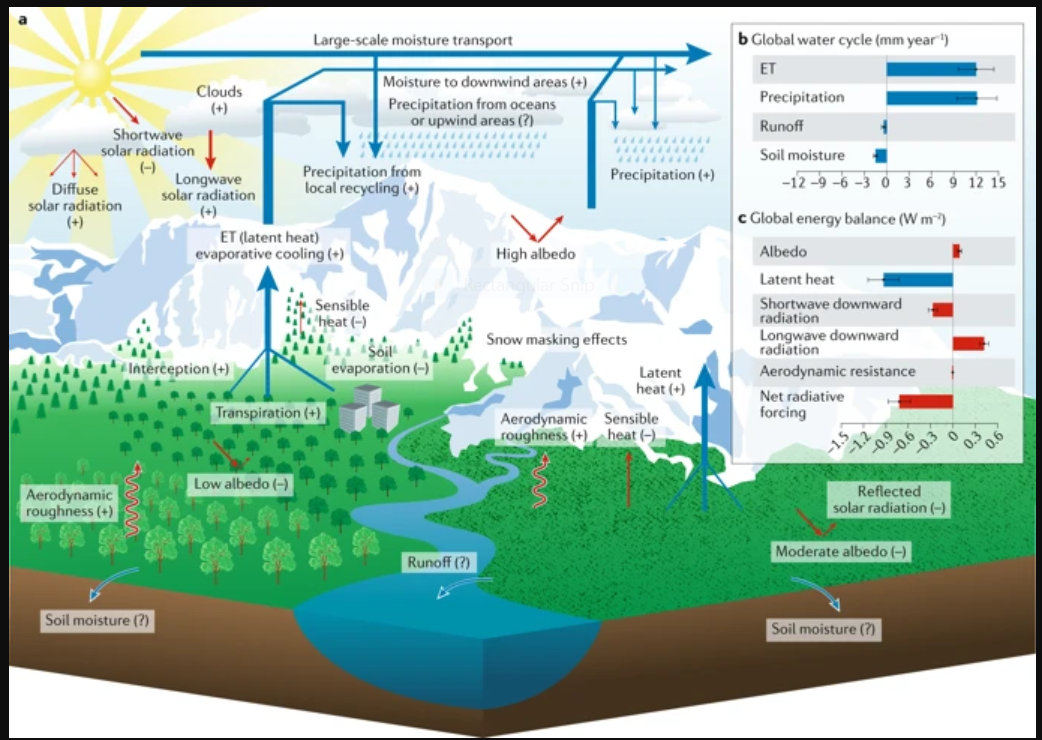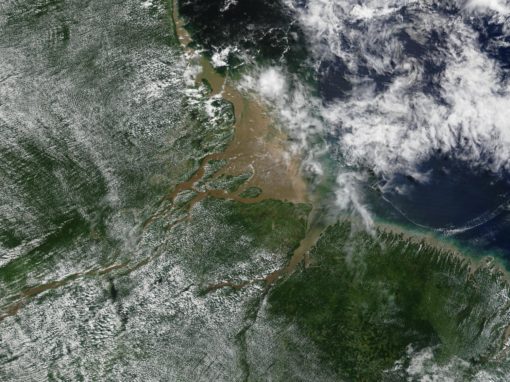This global greening effect, mainly from higher CO2 levels, and in part from regional warming and human land-use change, was predicted long ago by IPCC research, it’s not really a surprise, exactly.
Climate “alarmists” tend to downplay it, for obvious reasons (it doesn’t support the narrative), but too much research is piling up to ignore it.
The key upshot seems to be that in toto, the effect is slowing the pace of projected global warming from GHGs.
It doesn’t mean that rainforests are just magically regenerating from clearcut on their own, however, and much of the growth is said to be of small plants and underbrush, though it’s hard to see why it wouldn’t apply to large tree canopies as well.
As for any impact on the “Biotic Pump” effect, according to Julia Makarieva the full Biotic Pump requires very large areas of intact rainforest (“hundreds of hectares”) to effectively move atmospheric rivers of moisture far inland from the coasts.
So-called “Deniers” like to cite the Greening Effect as some sort of instant refutation of Catastrophic Anthropogenic Global Warming (CAGW).
Consensus researchers don’t deny the effect at all, but can often get themselves twisted up in rhetorical knots trying to downplay the complexity factors of the biosphere in climate research, and/or avoid any recognition of the possibly proactive behavior of the biosphere in response to stressorss, as per Margulis / Lovelock Gaia Hypothesis (Optimizing / Strong Version).
In general, the academic crew caution that the long-term effect of CO2 Fertilization is limited, because the other key nutrients that can support that growth are inherently more constrained (“Liebig’s Law”).
What they often don’t account for is that (soil, or oceanic) ecosystems are themselves hyper-complex and dynamic, with the microbiome and fungal kingdoms constantly revising and innovating their genomes to provide needed services to other critters, as mycorrhiza are now widely known to do for trees and other plants.
Bottom-Up Approaches to Synthetic Cooperation in Microbial Communities
&
Similar principles apply to ocean phytoplankton (bluegreen algae), that according to some studies are expanding, from the same CO2 fertilization effect, or according to others are declining or collapsing, due to acidification, or warming, or whatever.
Also plants tend to use water more efficiently under higher CO2, for what it’s worth.
This new meta-review study underlines the “It’s Complicated” aspect of it all.
One intriguing comment:
“’Plants are actively defending against the dangers of carbon pollution by not only sequestering carbon on land but also by wetting the atmosphere through transpiration of ground water and evaporation of precipitation intercepted by their bodies,’” says study coauthor Philippe Ciais, of the Laboratory of Climate and Environmental Sciences, Gif-sur-Yvette, France.” (Which sounds a bit more in the vein of #GaiaTheory — plant-life as an active player in global climate — than just a passive mechanistic effect from CO2 increase.)
From the study:
Abstract / Vegetation greenness has been increasing globally since at least 1981, when satellite technology enabled large-scale vegetation monitoring. The greening phenomenon, together with warming, sea-level rise and sea-ice decline, represents highly credible evidence of anthropogenic climate change. In this Review, we examine the detection of the greening signal, its causes and its consequences. Greening is pronounced over intensively farmed or afforested areas, such as in China and India, reflecting human activities. However, strong greening also occurs in biomes with low human footprint, such as the Arctic, where global change drivers play a dominant role. Vegetation models suggest that CO2 fertilization is the main driver of greening on the global scale, with other factors being notable at the regional scale. Modelling indicates that greening could mitigate global warming by increasing the carbon sink on land and altering biogeophysical processes, mainly evaporative cooling. Coupling high temporal and fine spatial resolution remote-sensing observations with ground measurements, increasing sampling in the tropics and Arctic, and modelling Earth systems in more detail will further our insights into the greening of Earth.
Key points
Long-term satellite records reveal a significant global greening of vegetated areas since the 1980s, which recent data suggest has continued past 2010.Pronounced greening is observed in China and India due to afforestation and agricultural intensification.
Global vegetation models suggest that CO2 fertilization is the main driver of global vegetation greening.
Warming is the major cause of greening in boreal and Arctic biomes, but has negative effects on greening in the tropics.
Greening was found to mitigate global warming through enhanced land carbon uptake and evaporative cooling, but might also lead to decreased albedo that could potentially cause local warming.
Greening enhances transpiration, a process that reduces soil moisture and runoff locally, but can either amplify or reduce runoff and soil moisture regionally through altering the pattern of precipitation.
Original study: https://www.nature.com/articles/s43017-019-0001-x
Popular summary from BU:
Bottom-Up Approaches to Synthetic Cooperation in Microbial Communities
&
Microbial carbon limitation: The need for integrating microorganisms into our understanding of ecosystem carbon cycling



